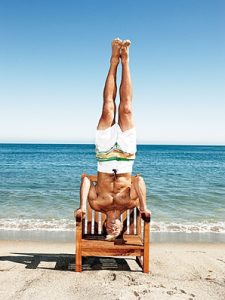 Written By Laird Hamilton for MensJournal.com
Written By Laird Hamilton for MensJournal.com
Credit: Photograph by Ture Lillegraven
California always reminds me of how bad sitting is for us. I spend half the year in Hawaii, where I’m constantly outside and never sitting that much, and half in Malibu, where I drive pretty much everywhere. All that time in the car tightens me up. Sitting in a car seat, especially after some sort of physical exertion, I just lock up. My body shuts down: My quads and core go slack, my glutes stay tense, and my lower back sets like concrete.
Whenever you sit, you crunch and compress yourself into a folding position in a way that engages some muscles while letting others relax, which creates imbalance. Whether you’re sitting at a desk at work or riding a bike, all the muscles on the front side of your body shorten after a while. Your fasciae (sheets of tissue around your muscles) tighten up, your hip flexors get tense, and forget about your psoas (so-az). The psoas is a long muscle that starts at the bottom of your spine, moves over the front of your hip joint, and attaches at the top of your thigh. Chairs shorten that up real nice, so when you finally stand, the psoas pulls down on your back. Now you’ve got a sore back. Sitting probably makes your back more sore than anything you do.
Studies have also linked sitting to increased risk of heart disease, diabetes, even colon cancer. Research shows that the more you sit, the shorter you’ll live. We can’t avoid sitting, but we can counteract it or learn to sit differently. The first thing I do when I get off the couch or out of a car is arch my back and open up into a back stretch, elongating the spine and taking some pressure off my lower back. I do it before I sit, too, to get the circulation going and minimize stiffness. Lately, I’ve been tilting my seat forward when I drive. Everyone wants to bring the bottom of the seat up, so their knees are high and they sink down, but if you adjust the seat to tilt forward and lower the front, it keeps you more engaged and open, so you have a little less tightness than you’d normally get.
Awareness of how you sit and what it’s doing to you is half the battle. Once you’re conscious of it, you can take steps to combat it. Some guys have gotten rid of the chair altogether and work at a stand-up desk. They love it. It’s change-your-life kind of stuff. And there’s always the ball, i.e. using a balance ball instead of a chair at your desk, for at least part of the day. So what if you’re the only one with a ball in his cubicle? The easy thing to do is to just line up and do what everybody else is doing. But that’s not often the right thing.

 Written By Laird Hamilton for MensJournal.com
Written By Laird Hamilton for MensJournal.com